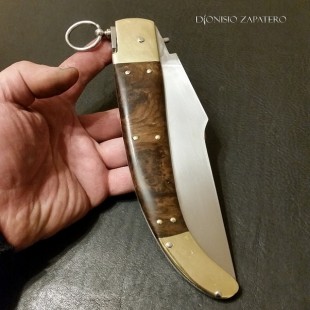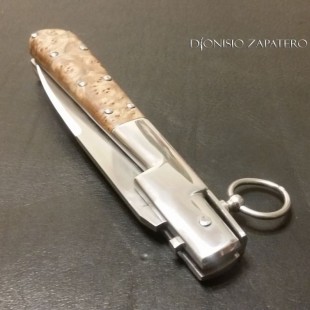Поиск:
Результаты поиска
Марка: Dionisio Zapatero
Каттер для сигар
Закрытый: 145мм
Открытый: 240мм
Клинок: нерж. сталь Bohler N690, 95 х 23 х 4ммБритвенные спуски (вогнутая линза), продольный сатин, традиционный
файлворк на обухе.
Лайнеры: нерж. сталь 420 (Франция), твёрдость 50-51 HRC
Пружина: нерж. сталь 420
Накладки: стабилизированный к..
260.00€
Без НДС:260.00€
Марка: Dionisio Zapatero
Альбасетская наваха орех 170 ммТрадиционная наваха из Альбасете с французскими элементами дизайна - замок, лайнеры.В открытом виде: 387 ммКлинок: нерж. сталь Bohler N690, 170 x 45 x 4 мм. Твёрдость 60 HRCСпуски прямые от обухаФиниш: ручной продольный сатин до 2000 гритПружина: нерж. сталь ..
377.00€
Без НДС:377.00€
Марка: Dionisio Zapatero
Баскская ятаганная наваха Шательро Традиционный для страны басков нож, с ятаганным типом клинка, вогнутым внутрь, к режущей кромке. Эти ножи классифицировались во Франции как "охотничьи" , выпускались мастерскими Шательро (Chatellerault) во второй половине XIX-начале XX вв., и..
330.00€
Без НДС:330.00€
Марка: Dionisio Zapatero
Диагональные кожаные ножныПоясные кастомные ножны для складного ножа. Диагональное размешение ножен позволяет комфортно и не привлекая внимания носить с собой даже большие складники с клинками 15-25 см. Этот тип ножен наиболее комфортно носить за спиной, ближе к левому или правому боку. Также,..
40.00€
Без НДС:40.00€
Марка: Dionisio Zapatero
Французско-испанская наваха, стилизованная под хвост гремучей змеи. Этот тип навах производился в Тьере для испанского рынка. В этой навахе используется очень интересная пружина - cran force. Этот замок был разработан французским оружейником в конце 1820-х. Хоть это и слипджойнт - то-есть, клинок, в..
340.00€
Без НДС:340.00€
Марка: Dionisio Zapatero
Дорогие друзья, - к сожалению, третий тираж книги закончился. О появлении следующего тиража сообщим дополнительно. Книга "Всемирная история поножовщины: народные дуэли на ножах в XVII-XX вв"Автор: Денис Леонидович ЧеревичникОб авторе: Историк, оружейник, культуролог, оружиевед, писатель. Презид..
30.00€
Без НДС:30.00€
Марка: Dionisio Zapatero
Корсиканская вендетта 125 мм рог лосяНаша версия , или скорее, "видение" легендарного складного ножа "Vendetta corsa", или "Корсиканская вендетта", который обычно ассоциируется с Корсикой. Честно говоря, прославленные корсиканские абреки-горцы, "bandits corses", или, как их ещё называли - "ban..
365.00€
Без НДС:365.00€
Марка: Dionisio Zapatero
Корсиканская вендеттаКорсиканская вендетта - складная версия печально известного генуэзского ножа XVIII века. В закрытом виде: 172 ммКлинок: 132 х 23 х 4 ммАвстрийская нерж. сталь Bohler N690.Спуски клинка: прямые, от обухаФиниш клинка: ручной продольный сатин до 1500 гритЛайнеры: нерж. сталь 4..
350.00€
Без НДС:350.00€
Марка: Dionisio Zapatero
Корсиканский нож "Vendetta corsa" (Корсиканская вендетта).Складная версия Генуэзского ножа XVIII века. Выпускалась на Корсике и во Франции с конца XIX в.В закрытом виде - 200мм
Клинок: 153 Х 24 Х 4 мм. Астрийская нерж. сталь
Bohler N690 - твёрдость 60HRC.
Спуски прямые от обуха, долы, фальш-лезви..
385.00€
Без НДС:385.00€
Марка: Dionisio Zapatero
Корсиканская вендетта рог 150 ммСкладная корсиканская версия прославленного генуэзского ножа XVIII векаВ закрытом виде: 182 ммКлинок: 150 х 20 х 4 ммАвстрийская нерж. сталь Bohler N690Твёрдость: 60 HRCСпуски: прямые от обухаФиниш: ручной продольный сатинБольстер: французская нерж. сталь 420 Нак..
340.00€
Без НДС:340.00€
Марка: Dionisio Zapatero
Корсиканская вендетта стабилизированный орех 165 ммВ закрытом виде: 206ммКлинок: 165 х 24 х 4 ммНерж сталь Bohler N690Спуски прямые от обуха.Ручной продольный сатин до 2000 гритБольстер: нерж. сталь 420 (Франция)Лайнеры: титанПружина: немецкая нерж сталь 1.4034 в стиле ШательроНакладки: стабилизиров..
350.00€
Без НДС:350.00€
Марка: Dionisio Zapatero
Наваха "Исабелина" аристократическая с крестомЭтот элегантный тип навах выпускался для испанского рынка в Тьере (Франция) и в первую очередь был рассчитан на представителей высших классов. Поэтому эти навахи известны как "aristocratica". Так как рукоятки этих навах часто инкрустировались сере..
385.00€
Без НДС:385.00€




-310x310w.jpg)




-310x310h.png)
-310x310w.png)

-310x310.jpg)
-310x310.jpg)







-310x310w.jpg)

